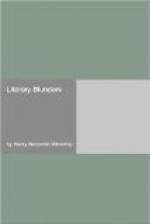``My profession obliging me to be conversant with mathematical Books (the printing whereof and musick, has been my chiefest employment), I have observ’d two things many times the cause why Books of this nature appear abroad not so correct as they should be; either 1 Because they are too much hastened from the Press, and not time enough allowed for the strict and deliberate examination of them; which in all books ought to be done, especially in these, for as much as one false figure in a Mathematical book, may prove a greater fault than a whole word mistake in books of another kind. Or, 2 Because Persons take Tables upon trust without trying them, and with them transcribe their errors, if not increase them. Both these I have carefully avoided, so that I have reason to believe (and think I may say it without vanity) there never was Tables more exactly printed than in this Book, especially those for money and p 89annuities, for not trusting to my first calculation of them, I new calculated every Table when it was in print, by the first printed sheet, and when I had so done I strictly compared it with my first calculation.’’
De Morgan registers the nineteenth edition of this book, dated 1756, in his Arithmetical Books, and he did not apparently know that it was originally published so early as 1679.
In Morton’s Natural History of Northamptonshire (1712), is a list headed ``Some Errata of the press to be corrected’’; and at the end of the list is the following amusing note: ``There is no cut of the Hen of the lesser Py’d Brambling in Tab. 13 tho’ ’tis referred to in p. 423 which omission was owing to an accident and is really not very material, the hen of that bird differing but little from the cock which is represented in that Table under fig. 3.’’
There is a very prevalent notion that authors did not correct the proofs of their books in the sixteenth and seventeenth centuries, but there is sufficient evidence p 90that this is altogether a mistake. Professor De Morgan, with his usual sagacity, alludes to this point in his Arithmetical Books (1847): ``A great many circumstances induce me to think that the general fashion of correcting the press by the author came in with the seventeenth century or thereabouts.’’ And he instances this note on the title-page of Richard Witt’s Arithmetical Questions (1613): ``Examined also and corrected at the Presse by the author himselfe.’’
The late Dr. Brinsley Nicholson raised this question in Notes and Queries in 1889, and by his research it is possible to antedate the practice by nearly forty years. For several of the following quotations I am indebted to that invaluable periodical. In Scot’s Hop-Garden (1574) we find the following excuse:—
``Forasmuch as M. Scot could not be present at the printing of this his booke, whereby I might have used his advice in the correction of the same, and especiallie of the Figures and Portratures conteyned therein, whereof he delivered unto me such notes as I p 91being unskilfull in the matter could not so thoroughly conceyve, nor so perfectly expresse as . . . the authour or you.’’




